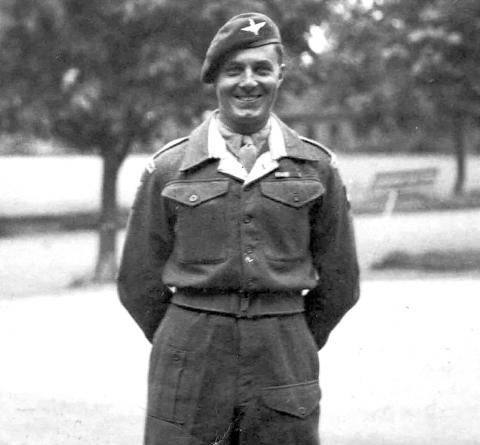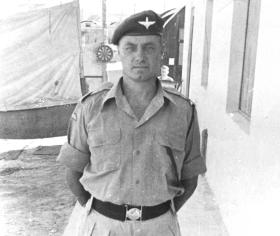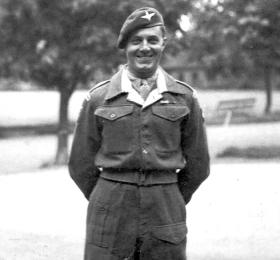John Hately was a veteran of the Battle of Arnhem who went onto become a Company Sergeant Major with 2 PARA during an Army career spanning 24 years. A popular and respected figure, John emigrated with his family to Australia where he helped to found the Pegasus Association WA, now known as the Airborne Forces Association WA.
One of his younger brothers Lance Corporal Robert Hately also served with The Parachute Regiment during World War II. He died in the first day of fighting in Normandy 6 June 1944, aged just 19 years old.
John Frederick Hately, who was born in Worcestershire in 1922, was the son of Reginald and Cecily Hately. The family later moved to London and John volunteered for the Territorial Army in 1939 aged just 17 years old. He was attested into the Queen’s Westminsters, a territorial unit of the King's Royal Rifle Corps.
In 1940 John’s battalion was converted to a motorised battalion equipped with the universal carrier. The following year the battalion was redesignated as the 11th (Queen’s Westminsters) Battalion, King's Royal Rifle Corps and assigned to 24th Army Tank Brigade (later known as 24th Armoured Brigade Group), which was then based in the United Kingdom.
The 24th Armoured Brigade, which formed part of the 8th Armoured Division, deployed to sea on 8 May 1942. They eventually arrived in Egypt some two months later on 8 July 1942 after a brief stay in South Africa.
John’s battalion took part in the Battle of Alamein between 23 October and 4 November 1942 as part of the 10th Armoured Division.
Shortly after the battle John’s battalion was reassigned to 9th Armoured Brigade, which deployed on 1 January 1943 to Syria. John volunteered for airborne forces while serving in Syria and qualified as a military parachutist at Kabrit in Egypt on course 85 later that year. He was posted to 4 Platoon, A Company, 156 Parachute Battalion. 156 Battalion formed part of the 4th Parachute Brigade which in turn was one of the brigades of the 1st Airborne Division.
After relocation to Tunisia, 156 Battalion formed part of the lead elements in the capture of the port of Taranto in Italy during September 1943. Facing a skilful German rearguard action they spent several weeks advancing north east, first to Bari and then Foggia.
John returned to the United Kingdom at the end of 1943 with the remainder of 1st Airborne Division in preparation for the campaign to liberate North-West Europe the following year. Throughout the summer of 1944, with the rest of the division, they trained, stood to for operations and repeatedly stood down; until eventually they were launched on the huge and ambitious Operation Market Garden in September 1944.
They took off from Saltby on 18 September, on the second day of the operation. Five of the brigade’s aircraft were shot down on the run in to the drop zone (DZ). John and other members of the 4th Parachute Brigade had to make their combat jump under enemy fire as part of the DZ at Ginkelse Heide (Ginkel Heath) was under German control. 156 Battalion moved in the direction of Arnhem from the DZ but encountered fierce German opposition. John was wounded in fighting on Wednesday 20 September in woods between Wolfeheze and Oosterbeek. He was captured by the Germans and held as a prisoner for the remainder of the war.
After repatriation to the UK, John opted to remain in the Army with The Parachute Regiment. He also married Wynne Cassidy in 1946. They were to remain married for 68 years until her death in 2015.
In February 1948, John was posted with the 5th Parachute Battalion, part of the 2nd Parachute Brigade Group to the British Army of the Rhine and garrisoned at Leicester Barracks, Husum in Germany. With the formation of the 16th Independent Parachute Brigade Group in 1948 the 5th (Scottish) Battalion was re-designated 2 PARA in July.
John completed most of his service with 2 PARA and was quickly promoted to Sergeant. In 1952 he was posted as a permanent staff instructor to the 18th Battalion, The Parachute Regiment (TA) and returned to 2 PARA in 1955.
In July 1956 John deployed with 2 PARA to conduct anti-terrorist operations against EOKA in Cyprus and in November 2 PARA participated in the sea-borne landings at Port Said during the Suez Crisis. In 1957 John was promoted to Company Sergeant Major. The following year 2 PARA flew into Amman Jordan as part of the 16th Parachute Brigade intervention force.
In 1959 John undertook a further posting to the TA, this time with 10 PARA. He returned to 2 PARA before retiring from the Army in 1963 after 24 years service.
John, his wife and family emigrated to Australia in 1968 and they settled in Perth. He was one of the founding members of the Pegasus Association (WA) later renamed as the Airborne Forces Association (WA), serving for many years as President of the association. He also spent 8 years as secretary of Highgate sub branch of the Returned and Services League of Australia and was also a warden at the Kings Park War Memorial for several years.
John Hately passed away in Perth WA on 24 December 2015 aged 93 years. His wife, and his two daughters pre-deceased him. He is survived by several grandchildren and great grandchildren.
Profile photograph courtesy of the Hately family and the Airborne Forces Association WA
Compiled by Harvey Grenville with the assistance of the Airborne Forces Association Western Australia.
Read More



Latest Comments
from 1959/1968
.I have photo of him on
21/st Birthday Parade Aldershot 1961.Doug Bates ex 10 Para
Add Comment
In order to add comments you must be registered with ParaData.
If you are currently a ParaData member please login.
If you are not currently a ParaData member but wish to get involved please register.